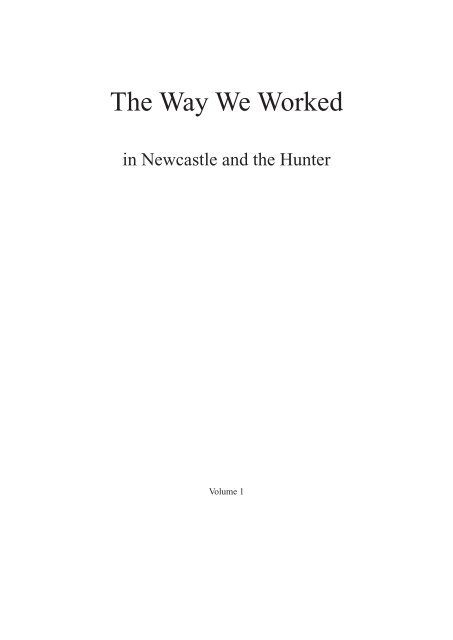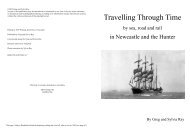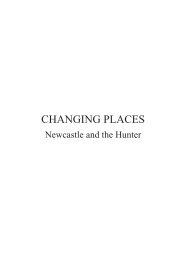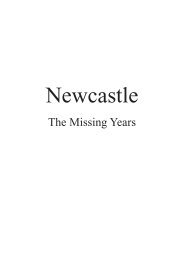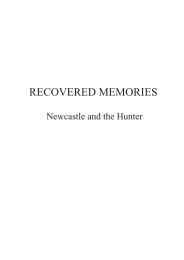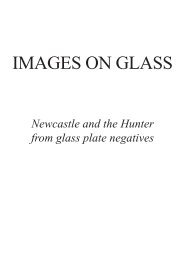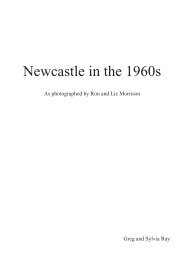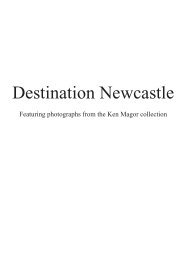the way we worked
Create successful ePaper yourself
Turn your PDF publications into a flip-book with our unique Google optimized e-Paper software.
The Way We Worked<br />
in Newcastle and <strong>the</strong> Hunter<br />
Volume 1
©2016 Greg and Sylvia Ray<br />
No part of this publication may be reproduced or transmitted in any form or by any means electronic<br />
or mechanical, and including photocopying, recording or by information storage and retrieval systems,<br />
without <strong>the</strong> written permission of <strong>the</strong> copyright owner.<br />
Printed by NCP Printing, Steel River, Newcastle<br />
Published by Greg and Sylvia Ray<br />
Concept and design by Greg and Sylvia Ray<br />
ISBN 978-0-9871883-6-6<br />
Front cover photo: A construction worker at Kurri Kurri’s Alcan aluminium smelter in 1968.<br />
Title page vignette: A young worker at BHP’s Newcastle steelworks in 1962.
The Way We Worked<br />
in Newcastle and <strong>the</strong> Hunter<br />
Volume 1<br />
By Greg and Sylvia Ray
The ever-changing face of work<br />
For <strong>the</strong> first tens of thousands of years of human habitation in <strong>the</strong> valley of <strong>the</strong> river <strong>we</strong> now call <strong>the</strong><br />
Hunter, work meant <strong>the</strong> direct day-to-day business of extracting food, shelter and o<strong>the</strong>r requirements from<br />
<strong>the</strong> natural environment.<br />
But when <strong>the</strong> British Empire claimed <strong>the</strong> continent of Australia and put it to use for <strong>the</strong> exiling of<br />
unwanted prisoners and political malcontents, convicts <strong>we</strong>re soon put to work at <strong>the</strong> Coal River extracting<br />
<strong>the</strong> fossil fuel that po<strong>we</strong>red <strong>the</strong> industrial revolution, as <strong>we</strong>ll as cedar and lime to help build Sydney. A new<br />
world of work, in which labour was a commodity to be traded or coerced, had arrived on Australian soil.<br />
Newcastle began as a secondary prison-within-a-prison for <strong>the</strong> colony’s most troublesome convicts. When<br />
<strong>the</strong> Hunter district’s isolation was broken by <strong>the</strong> discovery of overland routes from Sydney, farming moved<br />
in and turned <strong>the</strong> region into Sydney’s food-bowl, with Maitland as its prosperous centre.<br />
Next, large-scale private exploitation of <strong>the</strong> vast coal reserves beneath Newcastle created what many called<br />
a “Coalopolis” and, over <strong>the</strong> decades to come, industries of many kinds <strong>we</strong>re drawn to <strong>the</strong> mouth of <strong>the</strong><br />
Hunter River by <strong>the</strong> lure of cheap energy and abundant willing workers.<br />
World wars came and <strong>we</strong>nt. Industries sprouted, blossomed and died.<br />
In <strong>the</strong> 21st century Newcastle is a post-industrial city, and <strong>the</strong> Hunter might be described as a postagricultural<br />
valley, with massive-scale open-cut coalmining – mostly for <strong>the</strong> export market – one of <strong>the</strong> most<br />
visible players in <strong>the</strong> regional economy. But mining isn’t labour-intensive anymore, and <strong>the</strong> transnational<br />
corporations that dominate <strong>the</strong> sector are constantly seeking <strong>way</strong>s to make it even more capital-intensive.<br />
The really big employers, <strong>the</strong>se days, are in <strong>the</strong> service sectors.<br />
Manufacturing, a dominant sector in <strong>the</strong> Hunter in <strong>the</strong> second half of <strong>the</strong> 20th century, has suffered a<br />
spectacular decline as “globalisation” – <strong>the</strong> movement of capital investment in industrial production to<br />
countries with lo<strong>we</strong>r wages and environmental standards – has become <strong>the</strong> dominant force in economic and<br />
political life. Anybody observing Newcastle in <strong>the</strong> years from 1980 to 2000 would have seen industry after<br />
industry and factory after factory shutting down, displacing thousands of workers and rendering hard-won<br />
skills obsolete or unmarketable.<br />
This trend in <strong>the</strong> private sphere was accompanied in <strong>the</strong> public sector by increasing centralisation, typified<br />
by <strong>the</strong> withdrawal of local jobs, services and decision-making autonomy back to <strong>the</strong> state capital. Trade<br />
union po<strong>we</strong>r declined massively. The once influential Newcastle Trades Hall Council has declined in po<strong>we</strong>r<br />
and <strong>the</strong> mining union that could once stop <strong>the</strong> valley wields far less clout than in past years.<br />
From a personal perspective my experience may be typical. My paternal grandfa<strong>the</strong>r <strong>worked</strong> in various<br />
jobs around Newcastle, including as a coalminer and as a foreman with <strong>the</strong> Hunter District Water Board.<br />
My grandfa<strong>the</strong>r on my mo<strong>the</strong>r’s side <strong>worked</strong> at <strong>the</strong> BHP steelworks until he was injured at work and “let<br />
go” to find alternative employment outside <strong>the</strong> city as a rail<strong>way</strong> ganger. Both my grandmo<strong>the</strong>rs <strong>we</strong>re fully<br />
employed on “home duties” for most of <strong>the</strong>ir adult lives, though my maternal grandmo<strong>the</strong>r did some paid<br />
cleaning work to supplement <strong>the</strong> family income.<br />
My mo<strong>the</strong>r had some clerical jobs but marriage and childbirth intervened and, during much of her time as<br />
a potential member of <strong>the</strong> labour force married mo<strong>the</strong>rs <strong>we</strong>re not encouraged to seek paid work.<br />
My fa<strong>the</strong>r trained as a fitter and turner in <strong>the</strong> years when <strong>the</strong> metal trades <strong>we</strong>re ubiquitous in Newcastle,<br />
seizing <strong>the</strong> opportunity to switch to <strong>the</strong> drawing office and moving from Stewarts and Lloyds to <strong>the</strong><br />
Sulphide Corporation, which offered generous inducements for skilled employees and opportunities for his<br />
advancement into senior plant engineering roles.<br />
I recall being told while still at high school that I should prepare myself for a career in one of <strong>the</strong> big<br />
secondary industries – <strong>the</strong> BHP steelworks was highly recommended – and although I didn’t follow that<br />
advice I never suspected that <strong>the</strong> great steel plant’s days <strong>we</strong>re so nearly numbered as time proved <strong>the</strong>m to be.<br />
But few jobs are safe from change. My 30-year career in journalism was notable for <strong>the</strong> knowledge I had<br />
from my first day that newspaper circulation was declining. As time passed, massive changes <strong>we</strong>re adopted<br />
by media companies seeking to cut costs and maintain profits. Printers <strong>we</strong>re laid off wholesale and computer<br />
technology was embraced. Offshoring came. Formats changed. Content was trimmed. The onslaught of<br />
competing technologies – culminating in <strong>the</strong> internet – was an irresistible tide.<br />
What jobs or careers my three children may choose is unclear to me. Work is still changing.
This book, our seventh, is a celebration of work in <strong>the</strong> Hunter and its ever-evolving nature.<br />
We hope it will prove entertaining and informative to some readers, and that it will be a source of pleasant<br />
memories for those who spent some of <strong>the</strong>ir own working days in <strong>the</strong> industries and with <strong>the</strong> companies<br />
illustrated and described.<br />
As usual <strong>we</strong> have many people to thank for <strong>the</strong>ir help and kindness in assembling this collection of images<br />
and anecdotes. Jorg Griep, whose fa<strong>the</strong>r Horst took many photographs that appear in <strong>the</strong> book, was kind<br />
enough to make available a substantial collection of prints and negatives.<br />
Ron and Liz Morrison – our mentors in some <strong>way</strong>s – have also been exceptionally generous in permitting<br />
us to use some of <strong>the</strong>ir marvellous images. Norman and Betty Mead also shared information and photos.<br />
Ron Bell, a former colleague at The Newcastle Herald, provided still more negatives.<br />
We must acknowledge <strong>the</strong> enduring legacy of <strong>the</strong> late Ken Magor, whose collections started us on our<br />
publishing path in 2010, and of <strong>the</strong> families of <strong>the</strong> late Milton Merrilees and Arch Miller – both Herald<br />
photographers – who have helped us repeatedly. The same is true of Daphne Barney, wife of my late former<br />
Herald colleague Norm, whose unfailing support has been of immense value. Yvonne Austin, niece of <strong>the</strong><br />
late Douglass Baglin, has been very kind in letting us use some of her uncle’s wonderful work.<br />
Thanks too, to Brian Andrews, for helping me with details of coal industry history.<br />
Many o<strong>the</strong>r contributors deserve thanks, and some of <strong>the</strong>ir names will be found in <strong>the</strong> acknowledgement<br />
column at <strong>the</strong> end of <strong>the</strong> book. To my regret I have mislaid <strong>the</strong> details of some helpers, and can only say that<br />
I am sincerely sorry and will try to make up for my carelessness in any <strong>way</strong> I can.<br />
As al<strong>way</strong>s I thank my wife Sylvia for her skill and patience in making <strong>the</strong>se images as fit for printing and<br />
publication as can be, and for helping me make <strong>the</strong> transition in this past year from paid employment to selfemployment.<br />
Again, <strong>the</strong> changing nature of work . . .<br />
We intend this book to be <strong>the</strong> first in a series following <strong>the</strong> same <strong>the</strong>me, and encourage people with<br />
interesting pictures and stories about jobs and work in <strong>the</strong> Hunter to contact us at <strong>the</strong> email address in <strong>the</strong><br />
back of <strong>the</strong> volume.<br />
Greg Ray<br />
BHP steelworks was <strong>the</strong> definitive face of work in Newcastle for many decades.
The <strong>way</strong> <strong>we</strong> <strong>worked</strong>, for thousands of years<br />
The Hunter Region has been inhabited by human beings for tens of thousands of years, in which <strong>the</strong> most<br />
recent two centuries is a mere blink of an eye. For residents of <strong>the</strong> Hunter, <strong>the</strong> lifestyles of our Aboriginal<br />
forebears is of <strong>the</strong> greatest interest. These ancient people had a highly organised society based on a close<br />
relationship with <strong>the</strong> land and sea that provided all <strong>the</strong>ir needs for generations beyond telling.<br />
In such a society <strong>the</strong> concept of work could not help but differ greatly from <strong>the</strong> model imported by white<br />
convicts and settlers. European colonists brought <strong>the</strong> seeds of industrial economics and <strong>the</strong> principles of<br />
individual ownership of land and livestock – ideas that seemed alien and absurd to indigenous people whose<br />
lives <strong>we</strong>re organised around extended family, clan and tribal centres.<br />
Sadly little is reliably known about <strong>the</strong> long-term occupants of <strong>the</strong> country now known as <strong>the</strong> Hunter<br />
Valley. Many of <strong>the</strong>ir words survive in place names – albeit twisted and garbled to suit tongues accustomed<br />
to different sounds. And some contemporaneous accounts of <strong>the</strong> earlier people exist in writing, offering<br />
tantalising glimpses of a romantic and fascinating past where seemingly simple technologies had evolved to<br />
exceptionally high standards and where <strong>the</strong> everyday skills applied to <strong>the</strong> challenges of living would amaze<br />
and baffle most inhabitants of modern cities and towns.<br />
Food, water, shelter, entertainment, defence, clothing and adornment, trade and transport are common<br />
human wants, and <strong>the</strong> efforts involved in satisfying <strong>the</strong>se wants are what <strong>we</strong> call “work”. In a superspecialised<br />
society like <strong>the</strong> dominant 21st century industrial model, work shifts with changing fashions and<br />
technologies and, most of all, with global flows of money that constantly seeks <strong>the</strong> lo<strong>we</strong>st-priced inputs to<br />
ensure <strong>the</strong> highest possible profits from <strong>the</strong> sale of goods and services. Skills acquired over a lifetime of<br />
work can be rendered redundant almost overnight.<br />
In hunter-ga<strong>the</strong>rer societies, work skills refined by generations of trial and error could be acquired to a<br />
greater or lesser extent by every member of <strong>the</strong> community and <strong>the</strong>se skills <strong>we</strong>re passed from hand to hand<br />
and mouth to mouth over immeasurable periods of time.<br />
When <strong>the</strong> United States Exploring Expedition visited NSW in 1839, its observers remarked that:<br />
“The natives of New South Wales are a proud, high-tempered race: each man is independent of his<br />
neighbour, owning no superior, and exacting no deference; <strong>the</strong>y have not in <strong>the</strong>ir language any word<br />
signifying a chief or superior, nor to command or serve. Each individual is <strong>the</strong> source of his own comforts,<br />
and <strong>the</strong> artificer of his own household implements and <strong>we</strong>apons; and but for <strong>the</strong> love of companionship, he<br />
might live with his family apart and isolated from <strong>the</strong> rest, without sacrificing any advantages whatever.”<br />
Food was plentiful. Birds and animals filled <strong>the</strong> forests that grew around <strong>the</strong> rivers and swampy lowlands.<br />
Fish, molluscs and crustaceans teemed in <strong>the</strong> ocean and inland water<strong>way</strong>s.<br />
There was a big mutton bird colony on an island at <strong>the</strong> mouth of Lake Macquarie which was raided for<br />
eggs and chicks once a year, but protected with stringent laws at o<strong>the</strong>r times.<br />
Women fished with lines and nets and ga<strong>the</strong>red such vegetable staples as bracken fern roots (which <strong>we</strong>re<br />
roasted and pounded), <strong>the</strong> young stalks of <strong>the</strong> gigantic lily (soaked and roasted), nuts from <strong>the</strong> burrawong (a<br />
cycad, <strong>the</strong> nut of which had to be soaked for some time to remove toxins), wild plums and yam-like tubers<br />
of various kinds.<br />
The diary of Lieutenant William Sacheverall Coke, who was stationed at Newcastle in 1827, described <strong>the</strong><br />
abundance of seafood:<br />
“We can catch here eight or nine large fish called snapper in an hour – numbers of salmon, mullet – and <strong>we</strong><br />
are obliged to kill four or five sharks <strong>the</strong>re are so many here”. He wrote that <strong>the</strong> blacks swam to <strong>the</strong> seabed<br />
and returned with lobsters four times larger than those in England.<br />
1
Coke made sailing excursions to Ash Island, in <strong>the</strong> stream of <strong>the</strong> Hunter River, shooting wood pigeons that<br />
<strong>we</strong>ighed as much as kilogram. He reported seeing a herd of kangaroos, some black swans and thousands of<br />
ducks. In <strong>the</strong> Myall River he saw hundreds of pelicans and “wild ducks that almost covered <strong>the</strong> water”.<br />
At Port Stephens, women made fishing lines from <strong>the</strong> inner bark of young kurrajong trees. The bark was<br />
stripped and soaked in water until <strong>the</strong> outer portion could be scraped off with a shell, leaving a tough, flaxlike<br />
fibre. “The women twisted this fibre to <strong>the</strong> required length and thickness by rolling it on <strong>the</strong> front part of<br />
<strong>the</strong> thigh with <strong>the</strong> hands”. William Scott, son of an employee of <strong>the</strong> Australian Agricultural Company at Port<br />
Stephens, wrote that <strong>the</strong>se lines <strong>we</strong>re extraordinarily strong and capable of landing <strong>the</strong> heaviest fish. Hooks<br />
<strong>we</strong>re made from shell or bone.<br />
Bark canoes, made from a single flawless sheet of stringybark, <strong>we</strong>re used to criss-cross Port Stephens,<br />
Lake Macquarie and o<strong>the</strong>r water<strong>way</strong>s in <strong>the</strong> region. These al<strong>way</strong>s had a characteristic clay mound, often in<br />
<strong>the</strong> stern, where a small fire was kept burning while <strong>the</strong> canoes <strong>we</strong>re in use. Christian missionary Lancelot<br />
Threlkeld wrote that “it was a pleasing sight on a summer’s evening to see a number of <strong>the</strong> native canoes<br />
on <strong>the</strong> glasslike surface of <strong>the</strong> lake, sending up <strong>the</strong>ir strait columns of smoke from <strong>the</strong> centre of <strong>the</strong> barques,<br />
shewing an appearance of a fleet of small steamers at anchor in <strong>the</strong> stream. . . . The wild vines of <strong>the</strong> bush<br />
formed <strong>the</strong>ir cables and a heavy stone was <strong>the</strong> substitute for an anchor,” he wrote.<br />
The skill of <strong>the</strong> Aborigines with hunting spears was legendary. Early European settlers reported that <strong>the</strong><br />
spears <strong>we</strong>re very accurate up to 100m. Scott wrote that “with a woomera to aid <strong>the</strong> case, <strong>the</strong>y could hit a<br />
mark at almost every throw up to a distance of 50 to 75 yards”. The po<strong>we</strong>r and accuracy of <strong>the</strong> spear was<br />
enhanced by <strong>the</strong> use of a woomera, which acted as an extension of <strong>the</strong> thro<strong>we</strong>r’s arm. Observers commented<br />
on <strong>the</strong> amazing workmanship used in producing tools and <strong>we</strong>apons.<br />
Two sketches by artist Alfred<br />
Agate, who accompanied <strong>the</strong> US<br />
Exploring Expedition to NSW<br />
in 1839. At left is “Shingleman”<br />
of Lake Macquarie. At right is<br />
“Bamboo Cain” of Newcastle.<br />
Threlkeld wrote that <strong>the</strong> spears, mostly just over 2m long, <strong>we</strong>re often made in three parts, two being of<br />
grass tree stem and one of hardwood.<br />
“The ends of <strong>the</strong> grass tree are charred in <strong>the</strong> fire, fitted one into <strong>the</strong> o<strong>the</strong>r with <strong>the</strong> melted rosin infused,<br />
<strong>the</strong> joint is tied with a filament of bark, and a lump of gum wrapped around <strong>the</strong> joint, having <strong>the</strong> appearance<br />
of a ball of cobbler’s wax,” he wrote. “It is roasted over <strong>the</strong> fire and as it is softened by <strong>the</strong> heat, <strong>the</strong> gum is<br />
put into shape by <strong>the</strong> <strong>we</strong>tted fingers of <strong>the</strong> artisan.”<br />
The point was of fire-hardened hardwood, with perhaps some bone barbs. These spears <strong>we</strong>re mainly<br />
made on <strong>the</strong> coast and <strong>we</strong>re very popular as a trading item with inland tribes, who swapped such goods as<br />
decorated cloaks of kangaroo and possum skin and hand-spun ropes of possum-hide.<br />
Despite <strong>the</strong> fact that <strong>the</strong>y had few musical instruments (<strong>the</strong> didgeridoo was not used in NSW), <strong>the</strong> Hunter’s<br />
Aborigines <strong>we</strong>re a very musical people. They loved music and poetry and, as <strong>we</strong>ll as <strong>the</strong>ir acknowledged<br />
and sometimes sacred classics, <strong>the</strong>y had an ever-changing hit parade of new songs which <strong>we</strong>re shared from<br />
tribe to tribe as soon as <strong>the</strong>y <strong>we</strong>re written. People gifted in poetry, song and dance <strong>we</strong>re widely acclaimed<br />
and prized as star attractions at <strong>the</strong> highly social corroborees.<br />
According to Threlkeld, <strong>the</strong>re was an old man named Wullati who lived close to Moon Island, at <strong>the</strong> mouth<br />
of Lake Macquarie, and was famous for many miles around as a great poet, singer and performer.<br />
“He was very old, thin, small-headed and of a most cheerful disposition. Whenever he came to our tribe,<br />
his company was much enjoyed, an evening feast was provided and <strong>the</strong> choicest titbits <strong>we</strong>re set before <strong>the</strong><br />
toothless guest.” Wullati was a humorist and Threlkeld wrote that his stories and repartee would greatly<br />
amuse <strong>the</strong> revellers until, after <strong>the</strong> feast, he sang and danced to <strong>the</strong> musical accompaniment of two sticks.<br />
“The poets often make a song extempore, and if it happens to suit <strong>the</strong> humour of <strong>the</strong> tribe, its popularity is<br />
stamped . . . and messengers would be despatched from tribe to tribe to teach <strong>the</strong> melody to o<strong>the</strong>rs who in<br />
turn convey <strong>the</strong> new song set to music, without variation, to <strong>the</strong> most distant tribes in NSW.”<br />
2
The town and harbour of Newcastle, as depicted in an engraving in The Illustrated Sydney News of March 16,<br />
1865. The accompanying article states that: “T<strong>we</strong>nty years ago Newcastle was an insignificant village, with<br />
but a single coal mine – that of <strong>the</strong> AA Company which, enjoying a monopoly, was content with raising 25,000<br />
tons during <strong>the</strong> year”. By 1865 that lone mine had been joined by Waratah, Wallsend, Lambton, Minmi and<br />
o<strong>the</strong>rs, with rail lines to <strong>the</strong> port where four steam cranes loaded hundreds of vessels with cargoes of coal.<br />
An engraving of <strong>the</strong> Newcastle area, with St Johns Church, Cooks Hill, from The Illustrated Sydney News of<br />
August 16, 1865. The paper described <strong>the</strong> coal deposits of <strong>the</strong> Newcastle area as “of almost unlimited extent”.<br />
3
Chasing coal, from Newcastle to <strong>the</strong> valley<br />
It is hard to imagine what <strong>the</strong> Hunter Valley, and <strong>the</strong> harbour at <strong>the</strong> mouth of its namesake river, might<br />
have been like if it had not been for coal. The discovery of coal at <strong>the</strong> river north of <strong>the</strong> infant settlement of<br />
Sydney in <strong>the</strong> latter years of <strong>the</strong> 18th century prompted almost immediate efforts to extract it, and it wasn’t<br />
long before colonial governors started sending convicts north to work makeshift mines.<br />
In time <strong>the</strong> convict-operated mines gave <strong>way</strong> to <strong>the</strong> commercial operations of <strong>the</strong> Australian Agricultural<br />
Company, and soon that state-sponsored monopoly was forced to give <strong>way</strong> to numerous mining<br />
entrepreneurs. As mines spread out from what became <strong>the</strong> city of Newcastle, <strong>the</strong> shape of future suburbs was<br />
mapped, with houses, roads and rail and tram lines springing up to follow <strong>the</strong> coal and serve <strong>the</strong> miners.<br />
Australia’s first export was coal from Newcastle and, over <strong>the</strong> decades as <strong>the</strong> mines shifted inland and<br />
technology changed, <strong>the</strong> volumes of coal shipped through <strong>the</strong> port climbed to levels that <strong>the</strong> early pioneers<br />
could never have imagined possible.<br />
In <strong>the</strong> 21st century massive-scale open-cut mining has become <strong>the</strong> norm, and <strong>the</strong> industry has shifted<br />
from <strong>the</strong> labour-intensive pattern of <strong>the</strong> past to an increasingly capital-intensive and export-oriented model.<br />
Not long ago it was calculated that, if all <strong>the</strong> coal extracted from <strong>the</strong> Hunter in <strong>the</strong> 10 preceding years was<br />
stacked in a column one metre square, <strong>the</strong> column would reach to <strong>the</strong> moon and back, with plenty left over.<br />
While <strong>the</strong> days of <strong>the</strong> old underground pits, with <strong>the</strong>ir attendant armies of men and horses, are long gone,<br />
<strong>the</strong> legacy remains all around. The district is extensively undermined at many levels, with shafts and tunnels<br />
underlying <strong>the</strong> city and suburbs in a bewildering spider <strong>we</strong>b that no maps can illustrate with complete<br />
accuracy.<br />
Mining has changed or erased watercourses, altered landforms, changed <strong>the</strong> shoreline of Lake Macquarie<br />
and removed or altered forever some villages in <strong>the</strong> Hunter Valley.<br />
While modern mining is often characterised as “quarrying”, <strong>the</strong> practices of <strong>the</strong> past gave birth to<br />
many tasks and skills now rapidly being forgotten. Men now alive can recall with clarity <strong>the</strong> dangers and<br />
challenges of working deep underground, with po<strong>we</strong>r supplied by horses and with no more than timber<br />
props holding up <strong>the</strong> roofs and <strong>the</strong> threats from fire, gas and collapses an ever-present concern.<br />
A delightfully atmospheric early morning portrait of a group of wheelers and pit horses at Pelaw Main colliery.<br />
4
Mines and miners of <strong>the</strong> old days: Photograph above, by Ralph Snowball, shows Greta colliery in about 1902.<br />
Below: ano<strong>the</strong>r Snowball portrait of mining union delegates and officials at Lambton Colliery on May 27, 1897.<br />
5
Ralph Snowball photograph of miners near <strong>the</strong> train used to carry workers at Burwood Colliery, circa 1898.<br />
Below is ano<strong>the</strong>r typical Snowball portrait of pit top workers, probably at West Wallsend colliery, circa 1900.<br />
6
Horst Griep, above, <strong>worked</strong> in <strong>the</strong> Agfa factory in Germany before World War II and came to Australia after<br />
<strong>the</strong> war. After a short time at Greta migrant camp he <strong>we</strong>nt to work at <strong>the</strong> BHP steelworks where his skills <strong>we</strong>re<br />
noted by management and put to good use. His photo below shows <strong>the</strong> works from across <strong>the</strong> river in 1960.<br />
65
Above: BHP’s basic oxygen plant in 1962. The photograph below shows a worker in <strong>the</strong> rod mill in 1960.<br />
66
Above: A view across Newcastle’s steelworks in 1959. Below: Construction of <strong>the</strong> basic oxygen plant in 1962.<br />
67
A superb Horst Griep photograph showing construction of <strong>the</strong> No. 4 blast furnace at BHP Newcastle in 1963.<br />
68
69
These fine press photographs of various parts of <strong>the</strong> BHP Newcastle steelworks <strong>we</strong>re taken on January 20, 1949.<br />
70
Plenty of room for boys and girls at Big Harry’s Place<br />
“Big Harry’s Place”, as some liked to call <strong>the</strong> BHP steelworks, was a huge employer in Newcastle, training<br />
generations of tradespeople in a variety of skills. A keen employer of migrants, BHP also discovered an<br />
interest in employing women when <strong>the</strong> government put <strong>the</strong> brakes on overseas recruitment in <strong>the</strong> early<br />
1970s. Some of <strong>the</strong> first women taken on during this period found <strong>the</strong>mselves <strong>we</strong>aring <strong>the</strong>ir own casual<br />
clo<strong>the</strong>s to work, as <strong>the</strong> company-issue garments usually didn’t fit <strong>the</strong>m. The mostly male members of <strong>the</strong><br />
big unions at <strong>the</strong> steelworks had a mixed reaction to <strong>the</strong> appearance of women in <strong>the</strong>ir workplace, with most<br />
concerns centreing on <strong>the</strong> need for equality of pay. Some men frankly doubted <strong>the</strong> women could do <strong>the</strong><br />
work, a view that was quickly proven to be wrong.<br />
71
Above: Bernice Mat<strong>the</strong>ws, a recorder at <strong>the</strong> automatic bundling machine at No 2 merchant mill, <strong>we</strong>ighing<br />
steel for dispatch. Below: Carol Berry, shear roller line operator at No 2 merchant mill, cutting bars to length.<br />
72
Turton’s brickworks at East Maitland, from ground level (above) and from <strong>the</strong> air (below). Both circa 1930s.<br />
73
Men at work at a Waratah brickworks (above) and a nut and bolt factory at Foundry Street, Wickham, in 1905.<br />
74


